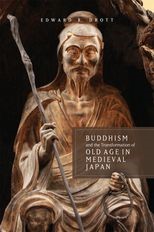Buddhism and the Transformation of Old Age in Medieval Japan
Buddhism and the Transformation of Old Age in Medieval Japan
Cite
Abstract
This book examines the shifting sets of meanings ascribed to the aged body in early and medieval Japan and the symbolic uses to which the aged body was put in the service of religious and religio-political ideologies. In the Nara through mid-Heian periods, old age was used as a symbol of weakness, ugliness or pollution to contrast with the glories of the sovereign and his or her efflorescent court. Concurrently, governmental and Buddhist retirement practices called for elders to remove themselves from social, political and cultural centers. From the late-Heian period forward, however, various marginalized individuals and groups took up the aged male body as a symbol of their collective identity and crafted narratives depicting its empowerment. Although in early Japan the terms okina and ōna had been reserved for strange or foolish underclass old men and women, in the medieval period, Buddhist authors presented a great number of gods (kami), Buddhist divinities, saints and immortals (sennin) as okina, or in rare cases, as ōna. In these years literati came to enthusiastically employ the persona of the aged Buddhist recluse and early Noh theorists and playwrights sought to enhance the prestige of their art by linking it to performance traditions featuring mysterious but powerful okina. Although many of the divinized okina of medieval myth are today seen to inhabit a “Shintō” pantheon, they were, in fact, the product of Buddhist texts and arose within a Buddhist cultural milieu.
-
Front Matter
-
Part I Making Elders Others in Early Japan
-
Part II Reappraising the Aged Body in Medieval Japan
-
Four
From Outcast to Saint: Overcoming Pollution in an Age of Decline
-
Five
The Eccentric Avatar: Reimagining the Body of the Bodhisattva in Early Medieval Engi
-
Six
The Graying of the Gods: The Return of the Okina Kami in Medieval Myth
-
Seven
“Tranquil Heart, Gazing Afar”: Reimagining the Aged Body in Noh
- Conclusion
-
Four
From Outcast to Saint: Overcoming Pollution in an Age of Decline
-
End Matter
Sign in
Personal account
- Sign in with email/username & password
- Get email alerts
- Save searches
- Purchase content
- Activate your purchase/trial code
Institutional access
-
Sign in through your institution
- Sign in with a library card Sign in with username/password Recommend to your librarian
Institutional account management
Sign in as administratorPurchase
Our books are available by subscription or purchase to libraries and institutions.
Purchasing information| Month: | Total Views: |
|---|---|
| November 2023 | 1 |
| November 2023 | 2 |
| December 2023 | 1 |
| February 2024 | 1 |
| April 2024 | 1 |



Get help with access
Institutional access
Access to content on Oxford Academic is often provided through institutional subscriptions and purchases. If you are a member of an institution with an active account, you may be able to access content in one of the following ways:
IP based access
Typically, access is provided across an institutional network to a range of IP addresses. This authentication occurs automatically, and it is not possible to sign out of an IP authenticated account.
Sign in through your institution
Choose this option to get remote access when outside your institution. Shibboleth/Open Athens technology is used to provide single sign-on between your institution’s website and Oxford Academic.
If your institution is not listed or you cannot sign in to your institution’s website, please contact your librarian or administrator.
Sign in with a library card
Enter your library card number to sign in. If you cannot sign in, please contact your librarian.
Society Members
Society member access to a journal is achieved in one of the following ways:
Sign in through society site
Many societies offer single sign-on between the society website and Oxford Academic. If you see ‘Sign in through society site’ in the sign in pane within a journal:
If you do not have a society account or have forgotten your username or password, please contact your society.
Sign in using a personal account
Some societies use Oxford Academic personal accounts to provide access to their members. See below.
Personal account
A personal account can be used to get email alerts, save searches, purchase content, and activate subscriptions.
Some societies use Oxford Academic personal accounts to provide access to their members.
Viewing your signed in accounts
Click the account icon in the top right to:
Signed in but can't access content
Oxford Academic is home to a wide variety of products. The institutional subscription may not cover the content that you are trying to access. If you believe you should have access to that content, please contact your librarian.
Institutional account management
For librarians and administrators, your personal account also provides access to institutional account management. Here you will find options to view and activate subscriptions, manage institutional settings and access options, access usage statistics, and more.